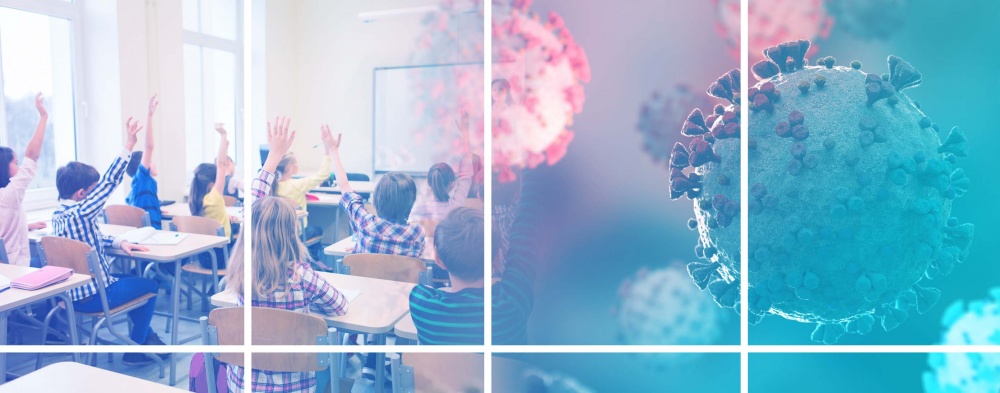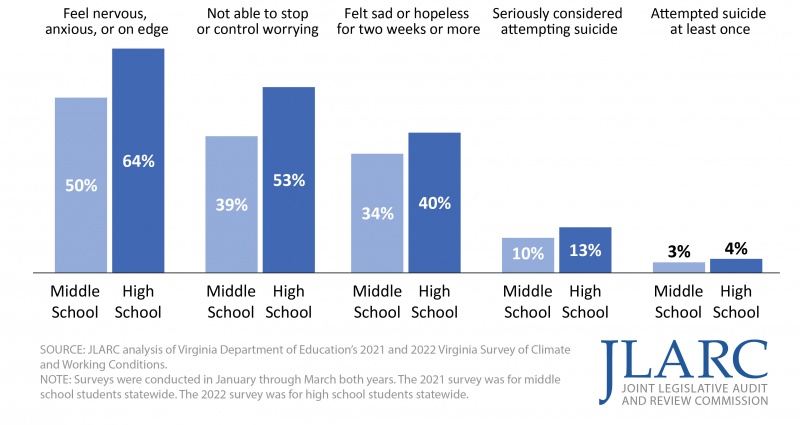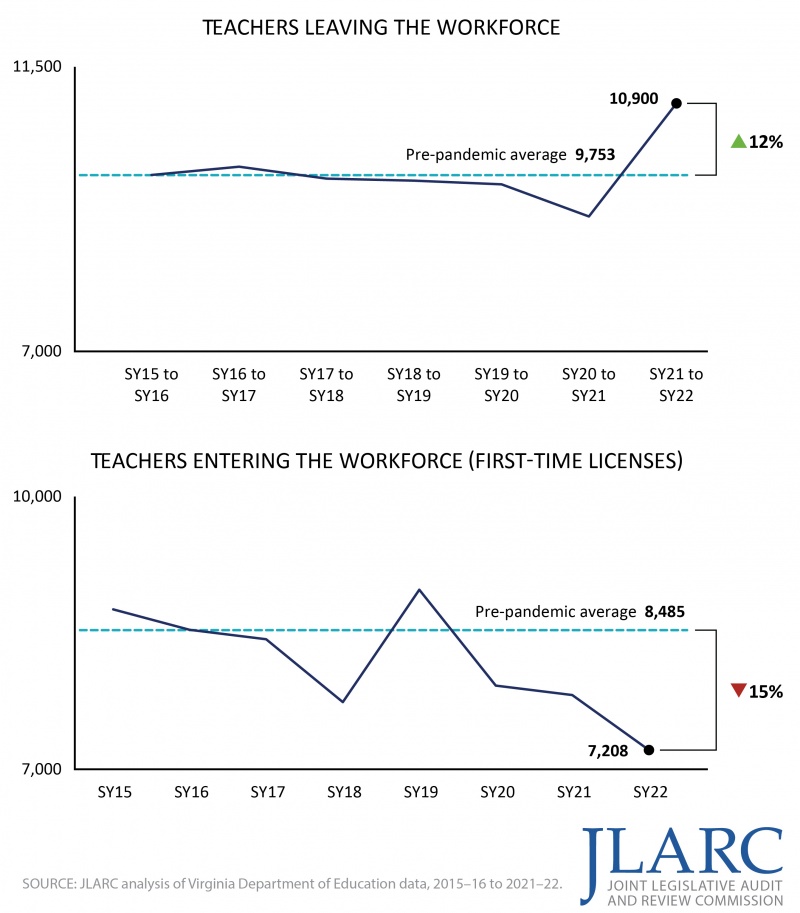Pandemic Impact on Public K-12 Education

WHY WE DID THIS STUDY
The 2021 General Assembly (SJ308) directed the Joint Legislative Audit and Review Commission (JLARC) to review the impact of the COVID-19 pandemic on the state’s K–12 education system.
ABOUT K-12 AND THE COVID-19 IMPACT
The pandemic resulted in divisions converting to remote learning for the second half of the 2019–20 school year and much of the 2020–21 school year. Rural divisions in western Virginia generally returned to in-person learning sooner than other divisions. This major, unprecedented disruption presented numerous challenges for students, families, and K–12 staff.
WHAT WE FOUND
Chronic absenteeism and student behavior were major concerns as students returned to in-person instruction
As students returned to in-person instruction, fewer of them regularly attended school. Chronic absenteeism—a student missing 10 percent or more of school days—nearly doubled last year compared with pre-pandemic rates. Twenty percent of students statewide were chronically absent in the 2021–22 school year. Nearly all school divisions in the 2021–22 school year experienced surges in chronic absenteeism, with just three divisions experiencing a decrease. While COVID-19 quarantines contributed to increased absenteeism, school staff indicated other factors contributed as well.
More students also exhibited disruptive behavior as they returned to in-person instruction, according to school staff (though quantifying the increase is difficult because of data limitations). JLARC asked school staff to rate the seriousness of 15 issues faced by school staff, such as teacher compensation, student academic progress, lack of respect from parents, and concerns about health during the pandemic. Student behavior problems were rated as the most serious of all 15 issues listed. Principals and teachers cited months spent out of the physical classroom as the main reason for increased student behavioral problems.
Mental health issues among students are concerningly prevalent
Students themselves, especially females, reported disconcertingly high levels of mental health issues during the pandemic. Half of middle school students and nearly two-thirds of high school students reported feeling nervous, anxious, or on edge (figure).
For a substantial portion of students, the mental health concerns are more serious. Ten percent of middle school students and 13 percent of high school students indicated that they seriously considered attempting suicide in the past 12 months. A smaller, but still significant, portion of middle school students (3 percent) and high school students (4 percent) indicated they had attempted suicide at least once. Substantially more female students than male students reported experiencing these mental health issues across all indicators.
Middle and high school students report concerning mental health issues

Academic achievement declined, especially among young students and in certain divisions
Prior to the pandemic, most key indicators of Virginia student academic achievement had been generally stable, with the exception of elementary school reading scores, which had been modestly declining for several years. However, the closure of schools in March 2020 began a period of unprecedented disruption to student learning. These disruptions resulted in many students missing critical academic content, and many students returning less prepared to learn and less engaged in class than before the pandemic, according to staff.
Student performance on SOL tests declined during the pandemic but is beginning to rebound. Average reading and math SOL scores during the 2021–22 school year were lower than average scores prior to the pandemic. Performance generally declined by more in math than reading. However, reading and math SOL scores and pass rates have improved substantially since the initial decline in 2020–21.
Student performance on SOL tests is especially low in a subset of divisions. For example, during 2021–22, in approximately:
- 20 divisions, more than half of third-graders failed their reading and/or math SOLs; and
- 60 divisions, more than half of eighth-graders failed their math SOL.
SOL scores declined by more in divisions that relied longer on remote instruction but have also rebounded more. For example, 2020–21 eighth-grade math SOL scores in school divisions that used remote instruction longer declined, on average, by 7 percentage points more than divisions that returned to in-person instruction sooner. However, these divisions that relied longer on remote instruction also generally rebounded by more in 2021–22. As of spring 2022, there was a 1 or 2 percentage point difference in SOL scores between divisions that relied on remote instruction longer and divisions that returned to in-person instruction sooner.
Virginia students do not take SOL tests until third grade, but other assessments provide insight into the pandemic’s effects on young students. For example, fewer first- and second-grade students met early childhood literacy benchmarks in 2021–22 compared with the year before the pandemic.
Virginia students’ test scores declined on the National Assessment of Educational Progress. Test results from early 2022 show that Virginia fourth-grade students’ scores declined on math and reading by more than the national average. Virginia fourth graders generally scored above the national average before the pandemic, but as of early 2022 had fallen close to the national average. Following the pandemic-related declines, Virginia’s fourth-grade students ranked 20th in math and 34th in reading.
Virginia’s eighth grade student scores declined by about the same amount as the national average. Virginia eighth-grade students ranked 10th in math and 22nd in reading.
Divisions are facing substantial challenges recruiting and retaining a qualified teacher workforce
Divisions report that the pandemic has made it more difficult to recruit and retain teachers. Division leadership in nearly all divisions surveyed (94 percent) indicated it has become more difficult to recruit classroom teachers than it was before the pandemic. Nearly as many divisions (90 percent) also indicated it has become more difficult to retain classroom teachers.
Statewide teacher workforce data shows that more teachers are leaving the profession, while fewer teachers are becoming licensed for the first time. After declining during the first part of the pandemic, the number of teachers leaving the profession rose substantially in the 2021–22 school year. By 2021–22, the number of teachers leaving the profession was 12 percent higher than the pre-pandemic yearly average (figure). Likewise, the number of newly licensed teachers for the 2021–22 school year was 15 percent below the pre-pandemic average.
More teachers leaving profession, while fewer teachers are receiving licenses

This growing gap between individuals leaving and entering the teaching profession helps explain the increase in vacant teaching positions. Before the pandemic, there were about 800 vacant teaching positions statewide. This increased substantially to about 2,800 vacant teaching positions (3 percent of all teaching positions) in October 2021. More recently, VDOE collected data from 111 divisions as of August 2022, finding approximately 3,300 teacher vacancies in just those 111 divisions—a 25 percent increase from the vacancies reported by these same divisions in October 2021.
Divisions also expressed concern about the declining quality of teacher applicants during the pandemic. Nearly all divisions surveyed (98 percent) indicated that an inadequate applicant pool for open positions was among their biggest challenges to meeting staffing needs. One division human resources director stated: “I’m surprised when we get an application from a fully qualified teacher.”
Statewide teacher data shows school divisions are relying more heavily on provisionally licensed teachers, rather than fully licensed teachers. The number of provisionally licensed teachers increased 24 percent during the 2021–22 school year compared with the pre-pandemic average. The number of teachers not fully endorsed in their content area (teaching “out of field”) more than doubled over the same time period.
School divisions were generally not confident they would be able to hire the teachers they needed this year. More than half of divisions (52 percent) were not optimistic about their ability to employ a suitable classroom teacher workforce for the 2022–23 school year. In addition, more teachers reported they are likely to leave during this school year. Fifteen percent of Virginia teachers indicated they are “definitely leaving” or “likely to leave” their job in public education by the end of the 2022–23 school year, compared with 9 percent before the pandemic.
Teacher morale and job satisfaction are lower since the start of the pandemic
The pandemic’s challenges have taken a toll on the remaining teacher workforce. Nearly three-fourths of teachers reported that their morale is lower since the pandemic. About two-thirds reported they are less satisfied with the job. Of the teachers who indicated they are likely to leave by the end of the 2022–23 school year, a majority cited the effects of the pandemic—including lower morale, reduced job satisfaction, and higher workload—as a contributing factor.
These pandemic-related effects, as well as other factors, are the primary reasons for teachers’ lower job satisfaction. Teachers cited the following issues as the most serious problems they face:
- a more challenging student population, including behavior issues (56 percent indicated this is a very serious issue);
- low pay (52 percent);
- lack of respect from parents and the public (47 percent); and
- higher workload because of unfilled vacancies (40 percent).
Most divisions are planning for future disruptions to in-person instruction, but some staff still report feeling unprepared
Most school divisions have, or are in the process of developing, plans to deliver long-term remote instruction if necessary. As of summer 2022, 73 percent of divisions reported they have developed a formal document or plan to use for a future disruption to in-person learning. The remaining divisions reported they are currently developing a plan (8 percent), or planning to develop one in the future (18 percent).
Nearly all school staff surveyed indicated that it is very important to effectively plan for remote learning, and the majority reported they would be prepared. However, 41 percent of teachers and 22 percent of principals responded that they felt either not prepared or only somewhat prepared to return to remote instruction should it be necessary. The number of staff feeling unprepared will likely increase in future years as turnover results in fewer teachers and other staff having first-hand experience in delivering remote instruction.
WHAT WE RECOMMEND
Legislative action
- Amend the Code of Virginia to define direct school counseling services and allow qualified, licensed psychologists in other fields to be provisionally licensed as school psychologists.
- Create and fund a temporary math instructional improvement program to help elementary school students who fail their math Standards of Learning test.
- Provide temporary state funding to hire more instructional assistants to help provide individualized instruction and classroom management support.
- Provide temporary state funding for targeted retention and recruitment bonuses and tuition assistance to help provisionally licensed teachers become fully licensed.
WHAT WE RECOMMEND
Executive action
- Finalize and release the model memorandum of understanding to help interested divisions establish partnerships with community mental health providers.
- Develop and make available a standard template school divisions can use to develop plans for future prolonged periods of remote instruction.
- Develop and offer courses related to teaching remotely or using virtual learning resources.
The complete list of recommendations is available here.

